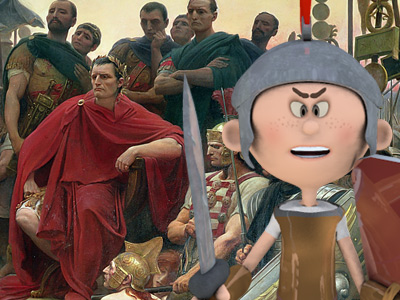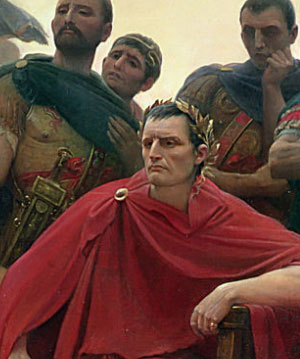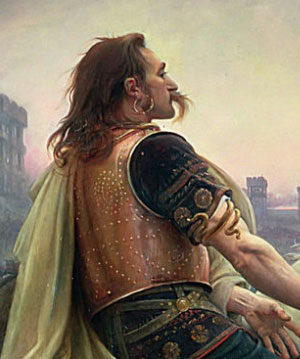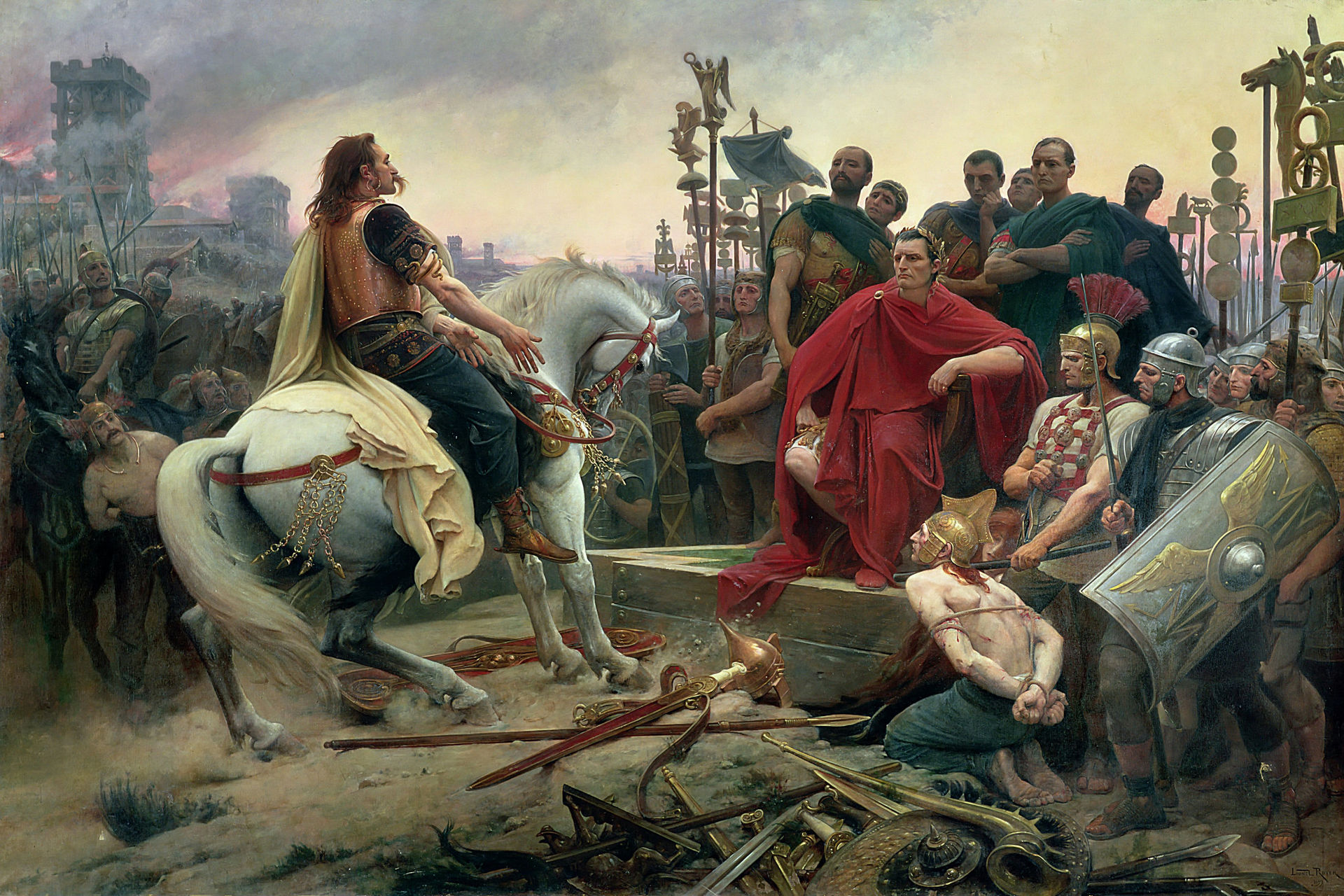Gallic Wars (58–50 BC)
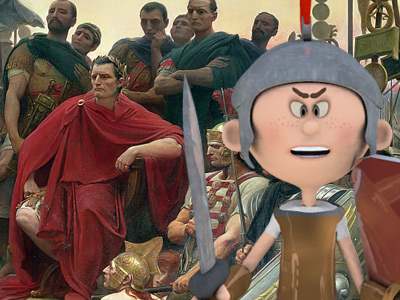
Beginning of the War - Campaign against the Helvetii
The Helvetii was a confederation of about five related Gallic tribes that lived on the Swiss plateau, hemmed in by the mountains, and the Rhine and Rhone rivers. They began to come under increased pressure from German tribes to the north and east.
By 58 BC, the Helvetii were well on their way in the planning and provisioning for a mass migration under the leadership of Orgetorix. Caesar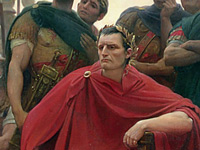 Julius Caesar (100-44 BC), was a Roman politician and general who played a critical role in the events that led to the demise of the Roman Republic and the rise of the Roman Empire. Caesar is considered by many historians to be one of the greatest military commanders in history. Julius Caesar » mentions as an additional reason their not being able to in turn raid for plunder themselves due to their location. They planned to travel across Gaul to the west coast, a route that would have taken them through lands of the Aedui, a Roman ally, and the Roman province of Transalpine Gaul.
Julius Caesar (100-44 BC), was a Roman politician and general who played a critical role in the events that led to the demise of the Roman Republic and the rise of the Roman Empire. Caesar is considered by many historians to be one of the greatest military commanders in history. Julius Caesar » mentions as an additional reason their not being able to in turn raid for plunder themselves due to their location. They planned to travel across Gaul to the west coast, a route that would have taken them through lands of the Aedui, a Roman ally, and the Roman province of Transalpine Gaul.
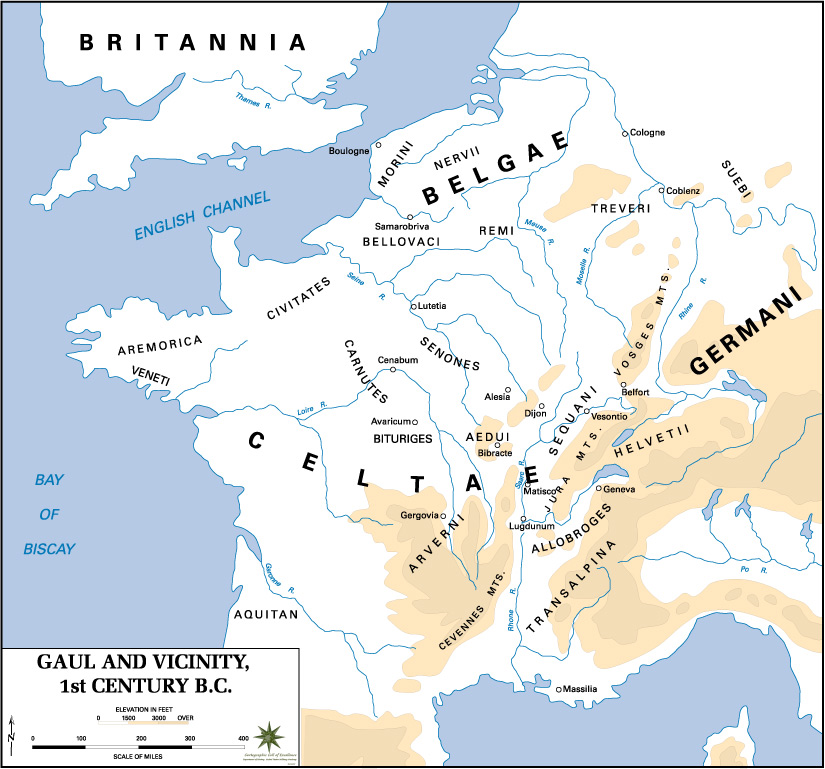
A map of Gaul in the 1st century BC, showing the relative positions of the Helvetii and the Sequani

A map of Gaul in the 1st century BC, showing the relative positions of the Helvetii and the Sequani
( Click image to enlarge)
The Helvetii sent emissaries to neighboring tribes to negotiate peaceful transit. Orgetorix made an alliance with the Sequani chieftain Casticus and arranged the marriage of his daughter to an Aedui chieftain, Dumnorix. The three secretly planned to become kings of their respective tribes, and masters of the whole of Gaul. Orgetorix's personal ambitions were discovered and he was to be put on trial, with the penalty being death by fire if convicted. Orgetorix escaped with the help of his many debtors, but he died during his flight. However, the death of Orgetorix was "not without suspicion that he had decided upon death for himself" (committed suicide), as Caesar puts it.
Caesar dated their departure to the 28 March, and mentions that they burned all their towns and villages so as to discourage thoughts among undecided client tribes and enemies of occupying their vacated realm.
Caesar was across the Alps in Italy when he received the news. With only a single legion in Transalpine Gaul, the endangered province, he immediately hurried to Geneva and ordered a levy of several auxiliary units and the destruction of the Rhone bridge. The Helvetii sent an embassy to negotiate a peaceful passage, promising to do no harm. Caesar stalled the negotiations for fifteen days, and used the time to fortify his position with a rampart nineteen miles long and a parallel trench.
When the embassy returned, Caesar refused their request and warned them that any forceful attempt to cross the river would be opposed. Several attempts were quickly beaten off. The Helvetii turned back and entered negotiations with the Sequani, and with Dumnorix of the Aeduans, for an alternate route.
Leaving his single legion under the command of his second-in-command Titus Labienus, Caesar hurried to Cisalpine Gaul. Upon arrival, he took command of the three legions which were in Aquileia and enrolled two new legions, the Legio XI and the Legio XII. At the head of these five legions, he went the quickest way through the Alps, crossing territories of several hostile tribes and fighting several skirmishes en route.
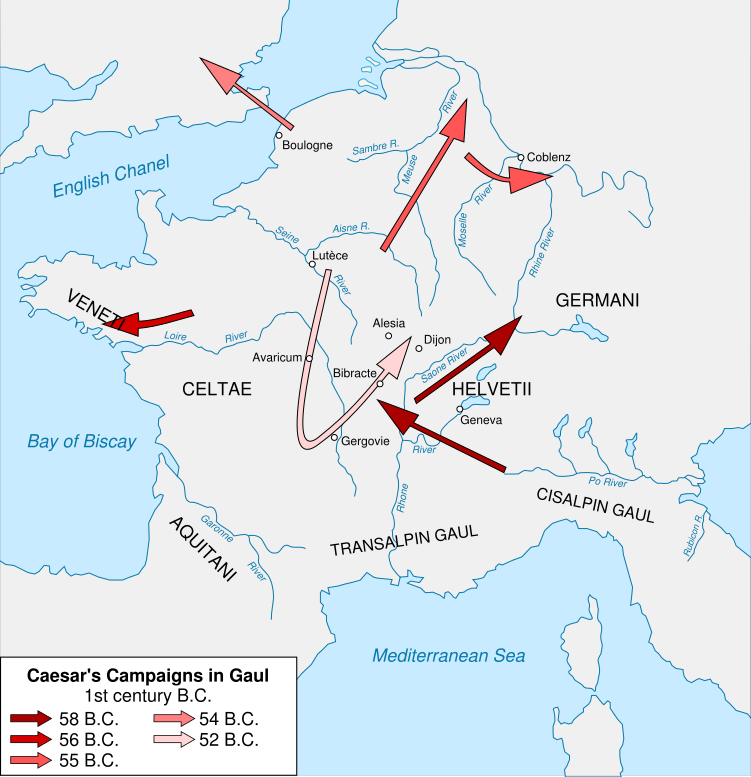
Map of the Gallic Wars

Map of the Gallic Wars
( Click image to enlarge)
Meanwhile, the Helvetii had already crossed the territories of the Sequani, and were busy pillaging the lands of the Aedui, Ambarri, and Allobroges. These tribes were unable to oppose them, and as Roman allies asked for Caesar's help. Caesar obliged them and surprised the Helvetii as they were crossing the river Arar (modern Saône River). Three quarters of the Helvetii had already crossed, but one quarter, the Tigurine (a Helvetian clan), was still on the east bank. Three legions, under Caesar's command, surprised and defeated the Tigurine in the Battle of the Arar. The remaining Tigurini fled to neighboring woods.
After the battle, the Romans The Roman Republic was a form of government of Rome and the era of the classical Roman civilization when it was run through public representation of the Roman people. Beginning with the overthrow of the Roman Kingdom (traditionally dated to 509 BC) and ending in 27 BC with the establishment of the Roman Empire, Rome's control rapidly expanded during this period - from the city's immediate surroundings to hegemony over the entire Mediterranean world. built a bridge over the Saône to pursue the remaining Helvetii. The Helvetii sent an embassy led by Divico, but the negotiations failed. For a fortnight, the Romans maintained their pursuit until they ran into supply troubles. Caesar, in the meantime, sent 4,000 Roman and allied Aedui cavalry to track the Helvetii, which suffered some casualties from only 500 Helvetii cavalry ("pauci de nostris cadunt"). Apparently Dumnorix was doing everything in his power to delay the supplies. Accordingly, the Romans stopped their pursuit and headed for the Aedui town of Bibracte. The tables were turned, and the Helvetii began to pursue the Romans, harassing their rear guard. Caesar chose a nearby hill to offer battle and the Roman legions stood to face their enemies.
The Roman Republic was a form of government of Rome and the era of the classical Roman civilization when it was run through public representation of the Roman people. Beginning with the overthrow of the Roman Kingdom (traditionally dated to 509 BC) and ending in 27 BC with the establishment of the Roman Empire, Rome's control rapidly expanded during this period - from the city's immediate surroundings to hegemony over the entire Mediterranean world. built a bridge over the Saône to pursue the remaining Helvetii. The Helvetii sent an embassy led by Divico, but the negotiations failed. For a fortnight, the Romans maintained their pursuit until they ran into supply troubles. Caesar, in the meantime, sent 4,000 Roman and allied Aedui cavalry to track the Helvetii, which suffered some casualties from only 500 Helvetii cavalry ("pauci de nostris cadunt"). Apparently Dumnorix was doing everything in his power to delay the supplies. Accordingly, the Romans stopped their pursuit and headed for the Aedui town of Bibracte. The tables were turned, and the Helvetii began to pursue the Romans, harassing their rear guard. Caesar chose a nearby hill to offer battle and the Roman legions stood to face their enemies.
In the ensuing Battle of Bibracte, the Celts and Romans fought for the better part of the day in a hotly contested battle with the Romans eventually gaining victory. Caesar writes that "the contest long and vigorously carried on with doubtful success." The defeated Helvetii offered their surrender, which Caesar accepted. However, 6,000 men of the Helvetian clan of the Verbigeni fled to avoid capture. Upon Caesar's orders, other Gallic tribes captured and returned these fugitives, who were executed. Those who had surrendered were ordered back to their homeland to rebuild it, and the necessary supplies were organized to feed them, as they were useful as a buffer between the Romans and the northern tribes. In the captured Helvetian camp, Caesar claims that a census written in Greek was found and studied: of a grand total of 368,000 Helvetii, of which 92,000 were able-bodied men, only 110,000 survivors were left to return home.
HISTORY
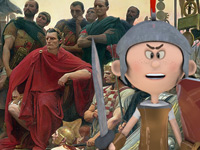
RESOURCES
This article uses material from the Wikipedia article "Gallic Wars", which is released under the Creative Commons Attribution-Share-Alike License 3.0.
© Stories Preschool. All Rights Reserved.
